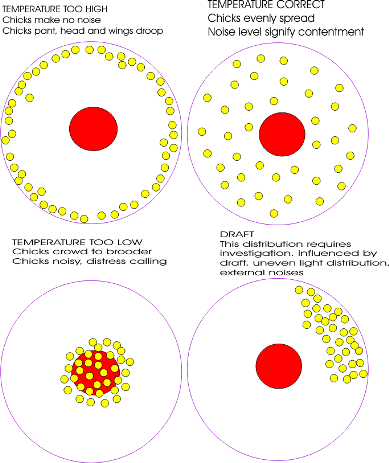Temperature control for brooding broiler chicks
There are two basic systems of temperature control for brooding broiler chicks i.e. spot brooding where the heat source is local, and whole house brooding where the heat source is widely spread.
In both spot and whole-house brooding systems, the objective is to stimulate both appetite and activity as early as possible. Achieving the optimum temperature is critical.
At all stages, monitor chick behavior to ensure that the chick is experiencing an adequate temperature. If subsequent behavior indicates that the chicks are too cold or too hot, the temperature of the house should be adjusted accordingly.
Optimal temperature and humidity are critical for health and appetite development. Monitor temperature and relative humidity frequently and regularly; at least twice daily in the first 5 days and daily thereafter. Use normal thermometers to check the temperatures at the chick level.
Ventilation without drafts is required during the brooding period to maintain temperatures and relative humidity (RH) at the correct level. It allows sufficient air exchange to prevent the accumulation of waste gases such as carbon dioxide and ammonia.
It is good practice to establish a minimum ventilation rate from day one. This will ensure that fresh air is supplied to the chicks at frequent and regular intervals. Internal circulation fans can be used to maintain evenness of air quality and temperature at chick level.
If a choice has to be made, maintenance of brooding temperatures should take priority over ventilation and air exchange. Young chicks are prone to wind-chill effects, therefore actual floor/air speed should be less than 0.15 m/sec or as low as possible.
Humidity
Monitor RH within the broiler house daily. If it falls below 50% in the first week, the environment will be dry and dusty. The chicks will begin to dehydrate and be predisposed to respiratory problems and performance will be adversely affected. Take action to increase RH. RH can be increased by using a backpack portable sprayer to spray the walls with a fine mist.
As the chick grows, the ideal RH falls. High RH (above 70%) from 18 days onwards can cause wet litter and its associated problems. As the broilers increase in live weight, RH levels can be controlled using ventilation and heating systems.
Spot Brooding
The heat source is local so chicks can move away to cooler areas and thus select for themselves a preferred temperature. Chicks are placed in an initial stocking density of 40 chicks/m2. If stocking density is increased, the number of feeders and drinkers, and the heating capacity of the brooder, should also be increased accordingly.
Spot Brooding Behavior
Chick behavior is the best indicator of correct brooder temperature. With spot brooding, correct temperature is indicated by chicks being evenly spread throughout the brooding area as shown below. In the diagram, the brooder area is shown as the red center circle.

Whole-house Brooding
The heat source is larger and more widely spread so chicks are less able to move to select a preferred temperature. The whole house or a defined part of the house is heated by ‘forced air heaters’ only and the aim is to achieve one temperature in the house or air space. There is no temperature gradient within the house, although supplementary brooders might also be provided. The main whole-house heat source can be direct or indirect (using hot air).
Whole-house Brooding Behavior
Chick behavior is the best indicator of correct temperature. The different distribution of chicks in whole-house brooding at different temperatures is shown below. With whole-house brooding, correct temperature is indicated by chicks forming groups of 20–30, with movement occurring between groups. There should be continuous feeding and drinking within the flock.

Carefully monitor and control house temperature and humidity when whole-house brooding is practiced.



